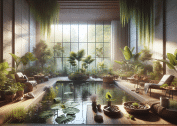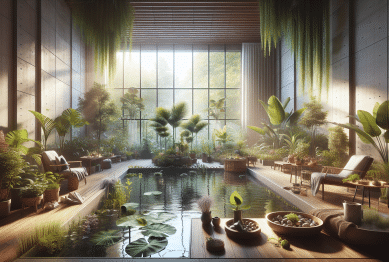Unlock the secrets to healthier indoor and outdoor plants by understanding advanced watering techniques. This guide explores how watering impacts growth, how to avoid common mistakes, and tips experts use for vibrant gardens—improving the beauty and health of your home environment.
Understanding Plant Watering Needs
Watering plants may sound simple, but getting it right is a subtle science. Each species in your home or garden responds uniquely to how much and how often you provide moisture. Some thrive in consistently damp soil, while others quickly suffer root rot when waterlogged. Factors like pot size, light exposure, and air humidity play a huge role. Not all plants require equal attention or receive the same benefits from the same routines.
Many gardeners feel frustrated when beloved plants wilt or develop yellow leaves. This disappointment often stems from a mismatch between plant needs and care routines. Understanding botanical cues can lead to a dramatic improvement in plant health and appearance. Examining leaf color, soil moisture, and growth patterns helps signal when it’s time to water, and when it’s wise to wait. These signals become more apparent as you observe the natural growth cycles in different environments.
Adapting your approach for houseplants versus outdoor gardens offers the best results. Indoor plants experience climate control, meaning their soil dries at a much different pace than outdoor beds. The water used, whether rainwater, filtered, or tap, influences mineral content and plant uptake. Utilizing moisture meters and studying how soil holds moisture enables not just survival but true thriving. Watering is far less about frequency and more about thoughtful observation.
Biggest Watering Mistakes Homeowners Make
Too much love can sometimes smother your plants. Overwatering remains the most common pitfall in both home and garden settings. When roots sit in stagnant water, they suffocate, leading to pale, limp foliage. Many species—especially succulents or cacti—retain water naturally. Their roots need aeration, not drowning. The temptation to water on a fixed schedule, regardless of conditions, leads to more harm than good.
Another frequent mistake is ignoring container drainage. Containers without adequate drainage holes trap water, risking disease and root decay. Placing a pot on a flat dish without periodically draining standing water can contribute to fungal problems. For in-ground beds, heavy clay or poorly amended soil keeps water from dispersing, causing soggy roots and disappointing blooms. Assess the bottom of pots and amend beds for better water flow.
Trying to revive a drooping plant with extra water is another issue. Wilting can result from both drought and oversaturation. Checking soil moisture levels with your finger or a simple probe before reaching for the watering can makes a difference. Sometimes, the best intervention is simply patience—letting soil dry before providing more hydration cultivates stronger, deeper root systems and healthier greenery overall.
How to Improve Water Retention and Drainage
The secret to lush, resilient plants often lies underground. Soil quality shapes both drainage and water-holding capacity, influencing plant success. Blends rich in organic matter—like compost or well-rotted manure—retain moisture yet stay airy enough for roots to breathe. Handmade potting mixes featuring peat moss, coconut coir, or perlite allow for customization based on plant needs. Experimenting with these ingredients lets you tailor care for everything from vegetables to delicate orchids.
For outdoor spaces, adding mulch transforms water management. Mulching with bark chips, straw, or even grass clippings locks moisture below the soil surface while suppressing weeds. This layer minimizes evaporation, keeping roots cooler and better hydrated in heat. Additionally, regular aeration loosens compacted soil, which can otherwise repel water and cause runoff. A hand fork or soil aerator works well in small beds or pots.
Even watering techniques matter. Pouring water directly onto the soil, rather than leaves, helps prevent the spread of mold and encourages moisture to reach the root zone. For larger gardens, using drip irrigation or soaker hoses delivers measured amounts right where needed, minimizing waste and promoting healthy, deep root growth. Setting up an irrigation system—even a simple one—can revolutionize how effectively plants absorb water in every part of your home landscape.
Timing and Frequency: When Should You Water?
Knowing when to water is as important as knowing how much. Plants typically absorb water most efficiently in the early morning, when evaporation rates are low and foliage has time to dry before nightfall. Watering at dawn allows moisture to penetrate deeply, supporting shoots as they open to the sun. During midday, rapid evaporation means less water reaches the roots and waste increases. In the evening, lingering dampness on leaves can breed fungal issues for many species.
Seasonal changes also deserve close attention in any watering schedule. Cool winter months demand much less frequent hydration, as dormant plants uptake less moisture. In summer, growth and evaporation rates spike, extending the need for monitoring soil dryness more often. Even rainfall frequency and the local microclimate around your home influence how often your garden should be watered. Taking notes on plant responses can help refine the ideal pattern for your unique space.
Tools such as self-watering spikes or moisture meters add precision, especially for beginner gardeners or forgetful plant enthusiasts. These devices aren’t a replacement for attentive care, but they help alleviate uncertainty and teach you to recognize when plants are truly thirsty. Combining observation with reliable tools ensures that both fragile houseplants and robust garden borders receive exactly what they need, exactly when they need it.
Selecting the Right Water for Your Plants
Water quality matters more than most people realize. Tap water often contains chlorine, fluoride, or dissolved minerals that some sensitive plants find challenging to process. Houseplants like spider plants or peace lilies may develop brown tips from the accumulation of these substances over time. Using filtered or rainwater minimizes harmful residues. Allowing tap water to sit for 24 hours before use can also let chemical additives dissipate, promoting healthier root and leaf development.
Hard water, common in many regions, contains higher concentrations of calcium and magnesium. Over time, this can alter soil pH and inhibit nutrient uptake. Regularly flushing the soil or using distilled water prevents these minerals from building up. For gardeners collecting rainwater, it’s essential to use clean containers and avoid runoff that may have picked up pollutants from roofs or gutters. Rainwater is the gold standard for most indoor and outdoor plants.
For specialty species such as orchids, carnivorous plants, or ferns, the ideal water may differ. These plants evolved in highly specific habitats and can react poorly to unfamiliar minerals or chemicals. Consulting expert guides, gardening forums, or botanical gardens helps clarify the optimal water source for challenging or prized varieties. Adapting water quality is one more way to elevate care and encourage lasting bloom and growth in every planting area of the home.
Smart Solutions for Efficient Watering
Garden technology has opened fresh opportunities for water conservation and convenience. Automated systems—including smart sprinklers and interconnected drip lines—identify weather patterns and soil moisture in real-time. These systems reduce water waste while ensuring targeted, efficient hydration, particularly in climates prone to drought or extreme heat. Investing in even the simplest automation offers peace of mind, especially for homeowners who travel or manage busy schedules.
Low-tech solutions remain powerful, too. Installing water butts to harvest rainwater, or using self-watering pots, ensures a steady, sustainable supply without increasing bills. Burying unglazed clay pots or bottles alongside roots—a technique practiced for centuries—slowly releases moisture and maintains steady soil hydration. Combining these approaches protects your landscape from weather variability and supports healthy plant growth throughout the year.
Conserving water isn’t just responsible; it’s also smart gardening. Mulch, shade cloth, and windbreaks help preserve soil moisture longer in container gardens as well as flower beds. Reviewing monthly water use encourages continual refinement. Experimentation, patience, and mindful observation come together—yielding deeply satisfying results and a greener, more vibrant home and garden for everyone to enjoy.
References
1. University of California Agriculture and Natural Resources. (n.d.). Watering Basics. Retrieved from https://ucanr.edu/sites/UrbanHort/Water_Use_of_Plants/Watering_Basics/
2. Royal Horticultural Society. (n.d.). How to water plants. Retrieved from https://www.rhs.org.uk/advice/profile?pid=387
3. Missouri Botanical Garden. (n.d.). Indoor plant care. Retrieved from https://www.missouribotanicalgarden.org/gardens-gardening/your-garden/help-for-the-home-gardener/advice-tips-resources/gardening-help-faqs/indoor-plant-care
4. Environmental Protection Agency. (n.d.). WaterSense for Homeowners. Retrieved from https://www.epa.gov/watersense/watersense-product-search
5. North Carolina State University Extension. (n.d.). The Basics of Watering Houseplants. Retrieved from https://content.ces.ncsu.edu/the-basics-of-watering-houseplants
6. Colorado State University Extension. (n.d.). Efficient Water Use in the Garden and Landscape. Retrieved from https://extension.colostate.edu/topic-areas/yard-garden/efficient-water-use-in-the-garden-and-landscape-7-233/









